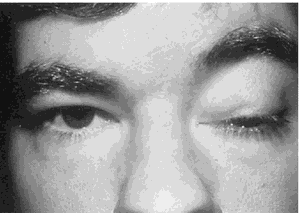Medical term:
ptosis
Ptosis
Definition
Ptosis is the term used for a drooping upper eyelid. Ptosis, also called blepharoptosis, can affect one or both eyes.
Description
The eyelids serve to protect and lubricate the outer eye. The upper eyelid is lifted by a muscle called the levator muscle. Inside the back part of the lid is a tarsal plate which adds rigidity to the lid. The levator muscle is attached to the tarsal plate by a flat tendon called the levator aponeurosis. When the muscle cannot lift the eyelid or lifts it only partially, the person is said to have a ptosis.
There are two types of ptosis, acquired and congenital. Acquired ptosis is more common. Congenital ptosis is present at birth. Both congenital and acquired ptosis can be, but are not necessarily, hereditary.
Causes and symptoms
Ptosis may occur because the levator muscle's attachment to the lid is weakening with age. Acquired ptosis can also be caused by a number of different things, such as disease that impairs the nerves, diabetes, injury, tumors, inflammation, or aneurysms. Congenital ptosis may be caused by a problem with nerve innervation or a weak muscle. Drooping eyelids may also be the result of diseases such as myotonic dystrophy or myasthenia gravis.
The primary symptom of ptosis is a drooping eyelid. Adults will notice a loss of visual field because the upper portion of the eye is covered. Children who are born with a ptosis usually tilt their head back in an effort to see under the obstruction. Some people raise their eyebrows in order to lift the lid slightly and therefore may appear to be frowning.
Diagnosis
Diagnosis of ptosis is usually made by observing the drooping eyelid. Finding the cause of the condition will require testing for any of the illnesses or injuries known to have this effect. Some possible tests include x rays and blood tests.
Treatment
Ptosis is usually treated surgically. Surgery can generally be done on an outpatient basis under local anesthetic. For minor drooping, a small amount of the eyelid tissue can be removed. For more pronounced ptosis the approach is to surgically shorten the levator muscle or connect the lid to the muscles of the eyebrow. Or, the aponeurosis can be reattached to the tarsal plate if it has separated. Correcting the ptosis is usually done only after determining the cause of the condition. For example, myasthenia gravis must be ruled out before performing any surgery. As with any surgery, there are risks, and they should be discussed with the surgeon.
Children with ptosis need not have surgery immediately, however their vision must be checked periodically to prevent lazy eye (amblyopia).
"Ptosis crutches" are also available. These can be attached to the frame of eyeglasses to hold up the eyelid. These devices are uncomfortable and usually not well tolerated.
Prognosis
After diagnosing the cause of a drooping eyelid, then correcting the condition, most people have no further problems related to the ptosis. The correction, however, may still not make the eyes symmetrical. Patients should have reasonable expectations and discuss the outcome with their doctor prior to surgery.
Prevention
Ptosis cannot be prevented.
Resources
Organizations
American Academy of Ophthalmology. 655 Beach Street, P.O. Box 7424, San Francisco, CA 94120-7424. http://www.eyenet.org.
American Medical Association. 515 N. State St., Chicago, IL 60612. (312) 464-5000. http://www.amaassn.org.
American Optometric Association. 243 North Lindbergh Blvd., St. Louis, MO 63141. (314) 991-4100. http://www.aoanet.org.
U.S. Department of Health and Human Services. 200 Independence Ave., SW, Washington, DC 20201, (202) 619-0257
Key terms
Congenital — A condition existing at birth.
Hereditary — A condition passed from parent to child. In other words, a genetic condition.
Gale Encyclopedia of Medicine. Copyright 2008 The Gale Group, Inc. All rights reserved.
ptosis
[to´sis]1. prolapse (def. 1).
2. paralytic drooping of the upper eyelid; called also blepharoptosis. adj., adj ptot´ic. (See Atlas 3, Part D).

Primary ptosis associated with left third nerve paralysis. From McQuillan et al., 2002.
Miller-Keane Encyclopedia and Dictionary of Medicine, Nursing, and Allied Health, Seventh Edition. © 2003 by Saunders, an imprint of Elsevier, Inc. All rights reserved.
pto·sis
, pl.pto·ses
(tō'sis, tō'sēz),1. A sinking down or prolapse of an organ.
2. Synonym(s): blepharoptosis
[G. ptōsis, a falling]
Farlex Partner Medical Dictionary © Farlex 2012
ptosis
(tō′sĭs)n. pl. pto·ses (-sēz)
Abnormal lowering or drooping of an organ or a part, especially a drooping of the upper eyelid caused by muscle weakness or paralysis.
pto′tic (-tĭk) adj.
The American Heritage® Medical Dictionary Copyright © 2007, 2004 by Houghton Mifflin Company. Published by Houghton Mifflin Company. All rights reserved.
ptosis
Drooping of an upper eyelid.Aetiology
Ageing, diabetes, stroke, Horner’s syndrome, myasthenia gravis, brain tumours or cancer.
Segen's Medical Dictionary. © 2012 Farlex, Inc. All rights reserved.
ptosis
Drooping eyelid Neurology A condition caused by weakened palpebral muscle, damage to nerves, or laxity of skin surrounding eye Risk factors Aging, DM, stroke, Horner's syndrome, myasthenia gravis, brain tumor, or cancer, which can affect nerve or muscle responseMcGraw-Hill Concise Dictionary of Modern Medicine. © 2002 by The McGraw-Hill Companies, Inc.
pto·sis
, pl. ptoses (tō'sis, -sēz)1. A sinking down or prolapse of an organ.
2. Synonym(s): blepharoptosis.
[G. ptōsis, a falling]
Medical Dictionary for the Health Professions and Nursing © Farlex 2012
ptosis
(tō′sĭs) [Gr. ptosis, a dropping]
PTOSIS: involutional ptosis, associated with the loss of elasticity of the eyelid
Dropping or drooping of an organ or part, as the upper eyelid from paralysis, or the visceral organs from weakness of the abdominal muscles. See: illustrationptotic (tŏt′ĭk), adjective; ptosed (tōst), adjective
Medical Dictionary, © 2009 Farlex and Partners
ptosis
Drooping of the upper eyelid. Ptosis may be a congenital weakness of the lid elevating muscle or may result from later injury or disease, such as MYASTHENIA GRAVIS, STROKE or a brain tumour. Ptosis can be corrected by surgery once the cause has been dealt with.Collins Dictionary of Medicine © Robert M. Youngson 2004, 2005
ptosis
Drooping of the upper eyelid causing a narrowing of the palpebral aperture. It is often divided into two main types: congenital and acquired. The congenital type present at birth is usually the result of interference with the superior division of the oculomotor nerve, or associated with the blepharophimosis syndrome. The acquired type may result from any affection of the nerve supply of the upper eyelid musculature, from a disease of the muscles themselves (e.g. myasthenia gravis), or from mechanical interference in elevating the eyelid due to the weight of a tumour, trauma or chronic tissue hypoxia (e.g. diabetes). The correction is usually surgical. Sometimes a ptosis crutch, which is attached to the spectacles and elevates the eyelid, may be useful. There are also special contact lenses designed to support the upper eyelid (Fig. P22). Syn. blepharoptosis. See hereditary spinal ataxia; epicanthus inversus; jaw-winking phenomenon; tuck procedure; pseudoptosis; Cogan's lid twitch sign; orthopaedic spectacles; Horner's syndrome.
acquired aponeurotic ptosis Ptosis caused by a partial disinsertion, dehiscence or weakness of the aponeurosis of the levator palpebrae superioris muscle. It usually occurs in old age and is bilateral, but disinsertion can result from trauma to one eye (e.g. following eye surgery). Occasionally an abnormal attachment to the superior border of the tarsal plate is present as well. This is the most common form of acquired ptosis. The typical treatment is by resection of the levator palpebrae muscle.
ptosis adiposa See dermatochalasis.
apparent ptosis See pseudoptosis.

acquired aponeurotic ptosis Ptosis caused by a partial disinsertion, dehiscence or weakness of the aponeurosis of the levator palpebrae superioris muscle. It usually occurs in old age and is bilateral, but disinsertion can result from trauma to one eye (e.g. following eye surgery). Occasionally an abnormal attachment to the superior border of the tarsal plate is present as well. This is the most common form of acquired ptosis. The typical treatment is by resection of the levator palpebrae muscle.
ptosis adiposa See dermatochalasis.
apparent ptosis See pseudoptosis.

Fig. P22 Congenital ptosis
Millodot: Dictionary of Optometry and Visual Science, 7th edition. © 2009 Butterworth-Heinemann
pto·sis
, pl. ptoses (tō'sis, -sēz)1. A sinking down or prolapse of an organ.
2. Synonym(s): blepharoptosis.
[G. ptōsis, a falling]
Medical Dictionary for the Dental Professions © Farlex 2012
Latest Searches:
Voraxaze - Voranil - Voorhoeve - voodoo - VOO - Vontrol - von - vomitus - vomiturition - vomitory - vomitoria - vomito - vomitive - vomiting - vomit - vomica - vomerovaginalis - vomerovaginal - vomerorostralis - vomerorostral -
- Service manuals - MBI Corp